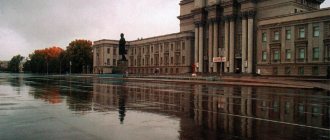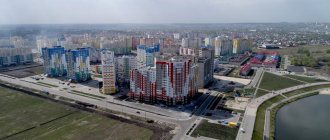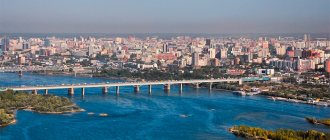A cozy resort town, administratively part of the Stavropol Territory, is considered the real capital of the Caucasian Mineral Waters. Coming here, you can not only experience the healing power of unique mineral springs, but also see the historical and architectural monuments of Pyatigorsk. Founded in 1830 at the foot of Mount Mashuk, the city quickly became the most popular resort in Russia. Its streets saw the flower of the Russian aristocracy; famous artists, writers, and poets received treatment here and found inspiration for their creations.
TOP-5 attractions of the city of Pyatigorsk
The city boasts magnificent natural and man-made attractions. You should start your acquaintance with Pyatigorsk by visiting several iconic places.
Mount Mashuk
- Address: you can get to the observation deck by cable car. Transport stop "Ropeway".
The main attraction of Pyatigorsk was awarded by nature itself. Mount Mashuk, whose height reaches 933 m, has been repeatedly sung by wonderful Russian writers and poets who visited the city, is truly magnificent. Walking along its picturesque slopes, M.Yu. Lermontov composed his wonderful poems, and General A.P. Ermolov developed plans for military operations of the Caucasian War. At the top of Mashuk, crowned with the peak of a television tower, there is an observation deck from which stunning panoramic views of Pyatigorsk and its surroundings open.
Details about Mount Mashuk
Pyatigorsk Eagle
- Address: not far from the Flower Garden. Transport stop "Tsvetnik".
The most recognizable symbol of Pyatigorsk, created by human hands, is considered to be a bronze sculpture of an eagle, placed on the rocky ledge of Mount Goryachaya. L. Shodky made the first version of the monument from concrete in 1901. Under the influence of winds and atmospheric moisture, the statue was constantly destroyed. Therefore, in 1973, it was decided to cast an exact copy of it in metal. The sculptural composition depicts an eagle engaged in a fight with a large snake. According to legend, the proud bird was once stung by an asp, but was successfully healed by drinking water from a mineral spring that flows at the foot of the mountain. It is believed that if you make a wish and rub the beak of a bronze eagle, it will definitely come true.
Failure
- Address: Mount Mashuk. Transport stop "Proval".
Arriving in Pyatigorsk, you simply cannot help but see the famous Lake Proval, located in a cone-shaped karst cave on the slope of Mount Mashuk. Before you get here, you will see a monument to a popular literary character - the elegant adventurer Ostap Bender, who knew 400 ways to “honestly” take money from citizens, one of which was the sale of non-existent tickets for sightseeing. Surrounded by gray rock, the bright turquoise lake looks stunning. Once its waters were used for medicinal purposes, but now it is a place of pilgrimage for city guests.
Obelisk at the site of the duel M.Yu. Lermontov
- Address: Transport stop “Place of duel M.Yu. Lermontov".
The last years of the life of the great poet M.Yu. are connected with Pyatigorsk. Lermontov, who managed to leave a bright mark in Russian literature in a very short life. A permanent monument on the northwestern slope of Mashuk was erected in 1915. in the supposed place of Mikhail Yuryevich's last duel . Here, on the morning of July 15, 1841, a bullet from N. Martynov’s pistol ended the life of a brilliant poet and brilliant officer. A dolomite obelisk of classical shape rises on a rectangular pedestal with a round niche in which a small bronze bust of Lermontov is placed. The square platform is framed by pillars with massive chains. Stone griffins sit at its corners.
Aeolian harp
- Address: Kalinina Avenue. Transport stop "Upper Market".
Such a romantic name goes to the magnificent rotunda, erected on the top of the Mikhailovsky spur of Mount Mashuk in 1831, which has since become one of the main symbols of Pyatigorsk. The elegant creation of the architect D. Bernardazzi seems to float in the air. The rotunda offers stunning views of the city, surrounding villages, and Mount Elbrus. Once upon a time, an original musical instrument was installed in it, consisting of two harps placed in a special box with slots. The sounds from it were produced by the wind itself, penetrating the box and touching the strings. Then the Aeolian harp was replaced by an electronic analogue, and since 2008, melodies in the rotunda have been played by an acoustic installation.
Graceful architecture
The architectural sights of Pyatigorsk, photos and descriptions of which are presented in this section, give the appearance of the city originality and charm. With the magnificent buildings as a backdrop, it's easy to take beautiful photos as a souvenir of your visit to the city.
Pushkin baths
- Address: Kirova Avenue, 3. Transport stop "Tsvetnik".
A complex of resort buildings, since 1924 bearing the name of the great poet A.S. Pushkin, built around a mineral spring discovered on a plot of land owned by General Sabaneev, received its first vacationers in 1901. In two buildings, built of yellow brick and white stone, there were 88 rooms for various purposes. Their interiors were decorated with airy arches, half-columns and tiled tiles. The exterior of the buildings amazes with its unique mixture of architectural styles. The facades of the buildings, decorated with magnificent stucco, attract people with the elegance of the turrets, the originality of the ornaments, and the abundance of stucco decorations.
Academic gallery
- Address: Kirova Avenue, 1A. Transport stop "Pirogovskie Baths".
One of the city’s iconic landmarks owes its appearance to Prince Vorontsov, who decided to build a beautiful pump room near a source with unique mineral water. And the building, designed by the British architect Samuel Upton, turned out to be truly magnificent. A luxurious palazzo in traditional Italian style, striking with its refined shapes and smooth lines. For the perfection of the building's architecture, as well as the skill of translating ideas into stone, Upton was subsequently awarded the title of academician. Today the building houses the exhibitions of the Insect Museum.
Elsa's dacha
- Address: st. Lermontova, 15. Transport stop “Upper Radon Baths”.
In Pyatigorsk, as in Barnaul, there is a house covered in urban legends. A mansion in the castle style with bay window towers topped with conical roofs with spiers was given to his wife Elsa by the prosperous confectioner Gukasov at the beginning of the last century. After some time, he left his wife, who was going through the divorce very hard. With the advent of Soviet power, the mansion was confiscated and converted into the Red Star sanatorium. Over time, vacationers began to hear women crying, moaning, footsteps at night, and complaining about the feeling that someone was watching them. It even reached the point of several suicides. They say that the spirit of Elsa, absolutely safe for women, took revenge on unfaithful husbands in a similar way. Now the building, in need of reconstruction, is in disrepair.
Tietz Brothers Mansion
- Address: Garanina Boulevard, 8. Transport stop "Upper Radon Clinic".
The stone building, which now houses a sanatorium owned by the Ministry of Defense, is considered one of the most beautiful in Pyatigorsk. The mansion, which attracts attention with its unusual architecture, was built more than 100 years ago for the successful city businessmen, the Tietz brothers. The architect E. Khadzhaev, who designed the structure, seemed to have decided to laugh at the laws of symmetry. At first glance, it seems that bay windows, mezzanines and loggias are placed chaotically, but overall the composition looks elegant and complete. The exterior of the mansion has everything from elegant attics to domes topped with spiers.
Chinese gazebo
- Address: top of Mount Goryachaya. Transport stop "Tsvetnik".
In addition to the Eagle sculpture, the top of Mount Goryachaya is decorated with an elegant architectural structure - a delightful gazebo in the Chinese style. It appeared here in 1976, taking the place of its predecessor, which was dismantled during the hard times for... firewood. The windows of the demolished gazebo were once decorated with stained glass windows made of multi-colored glass, creating stunning optical effects inside. The new building cannot boast of such delights, but this does not make it any less charming. An openwork gazebo, decorated with forged lace of amazingly fine workmanship, leaves a stunning impression.
Gukasov's coffee shop
- Address: Intersection of Kirov Avenue and st. Bernardazzi brothers. Transport stop "Tsvetnik".
A magnificent building not far from the Tsvetnik park, it amazes and delights with the sophistication of its architecture. The magnificent mansion, built in 1909 by order of the wealthy confectioner Gukasov, attracts with the smooth lines of the exterior, characteristic of pre-revolutionary Russian Art Nouveau. It is surrounded around the perimeter by a terrace with an elegant parapet. On the front side, the façade is decorated with two eclectic rotunda towers. Today, the first floor of the building is occupied by a private art gallery, the second floor is occupied by an aristocratic cafe, which is very popular among citizens and guests of the city.
Stay tips
Traditional souvenirs of Kavminvod can be considered mineral water and a special sanatorium mug for its use. Mineral water negatively affects tooth enamel, so it is best to drink it from a flat mug with a spout. The long spout protects teeth from direct contact with water. You can buy such funny dishes in all souvenir shops and drinking galleries in the city. Its cost starts from 100 rubles. Depending on the material, design and design of the mug, the price may increase.
A special “spout” on the mugs allows you to drink mineral water with minimal harm to tooth enamel
Mineral water should be bought in a store; it is unlikely that you will be able to treat your loved ones with water from the source: it is not intended for long-term storage. Water collected from springs quickly deteriorates and must be drunk immediately on the spot.
Try traditional Caucasian dishes and desserts. The Pyatigorsk cold storage plant produces ice cream whose taste is reminiscent of childhood.
Also common souvenirs from the Caucasus are spices, seasonings, oriental sweets and high-quality wool products.
What to see in Pyatigorsk in one day?
Among the many attractions of the city, there are several that no excursion would be complete without visiting. If you decide to explore Pyatigorsk on your own, be sure to visit the following places:
Diana's Grotto
- Address: Tsvetnik Park.
On July 10, 1829, during a geographical and cartographic expedition organized by the commander of the Caucasian Line troops, General Georgy Emanuel, Mount Elbrus was conquered. The authorities decided to immortalize this significant event in the Tsvetnik park. Under the leadership of the architect D. Bernardazzi, a reconstruction was created that exactly repeated the outline of Elbrus, and under it a grotto was carved into the rock. The entrance to the man-made cave is supported by two massive columns. On the wall next to them there used to be cast-iron memorial plaques telling about the ascent. Now they have been transferred to the local history museum.
Monument to M.Yu. Lermontov
- Address: Lermontovsky Square. Transport stop "Tsvetnik".
The life of M.Yu. was interrupted in Pyatigorsk. Lermontov, so it is not surprising that the first monument to him was erected here. Members of a specially created committee had a difficult task - to choose the best option from 120 submitted projects. The victory in the competition was won by a sketch of a bronze monument presented by sculptor A. Opekushin. In August 1889, the monument was inaugurated. The great poet is depicted overwhelmed with inspiration, looking at the magnificent Elbrus. At his feet lies a feather and an open book, as well as a lyre and a laurel wreath - symbols of the genius of Mikhail Yuryevich.
Fountain fairy tale
- Address: Square named after. L.N. Tolstoy. Transport stop "Children's World".
Tourists who come to relax in the city love to take pictures against the backdrop of the wonderful fountain. Although the hydraulic structure appeared here at the beginning of the last century, it received its current appearance later. One powerful geyser was replaced by several nozzles of smaller diameter. In the center of a large radial bowl, a stunningly beautiful grotto was built, decorated with bas-reliefs of fairy-tale gnomes. After multi-colored spotlights were installed around the fountain, it began to look simply fantastic.
Spassky Cathedral
- Opening hours: daily, from 7:00 to 19:00.
- Telephone.
- Website: https://www.spasskiy-sobor.ru
- Address: st. Sobornaya, 1A. Transport stop "Dzerzhinsky Street".
The history of the wonderful cathedral, very reminiscent in architecture of the Cathedral of Christ the Savior, is very eventful. Suffice it to say that it was built almost twice. Cracks appeared along the walls of the first version of the building already at the time of the construction of the domes. The building had to be demolished and the foundation further strengthened. As a result, the temple, founded in 1845, was consecrated only 22 years later. During the time of persecution of religion, a granary was first built in the church, and then it was completely blown up. The construction of a new temple, exactly recreated from surviving drawings and photographs, was completed in 2013.
Monument to A.P. Ermolov
- Address: st. Lermontov. Transport stop "Tarkhany".
In Pyatigorsk, a lot is connected with the name of the remarkable Russian military leader - the conqueror and pacifier of the Caucasus, General Ermolov. The brilliant officer, hero of the Patriotic War of 1812, did a lot for the development and prosperity of the city. At the beginning of this century, the authorities decided to perpetuate the memory of Alexei Petrovich. In the fall of 2010, in the presence of a delegation from the Kuban Cossack Army, a monument to the general was solemnly unveiled. The three-ton sculpture, cast from bronze, depicts Yermolov sitting on a horse in a military uniform.
Traveling at different times of the year
Pyatigorsk has a temperate continental climate. Summers here are warm and winters are relatively mild. Many resorts in the city are open year-round. However, experts recommend going for health treatments from April to October. The most comfortable time for educational tourism is the second half of spring, summer and early autumn. During this period it is convenient to climb mountains. It can rain frequently in early spring, which can cause inconvenience. From mid-April the air warms up to +15. Summer in Pyatigorsk is warm, sunny and without precipitation. The air temperature in July can reach +30. In November there are frosts and it may even snow. In winter there is a lot of snow, and the temperature usually stays between -5–6 degrees.
In early autumn, Pyatigorsk is especially beautiful








